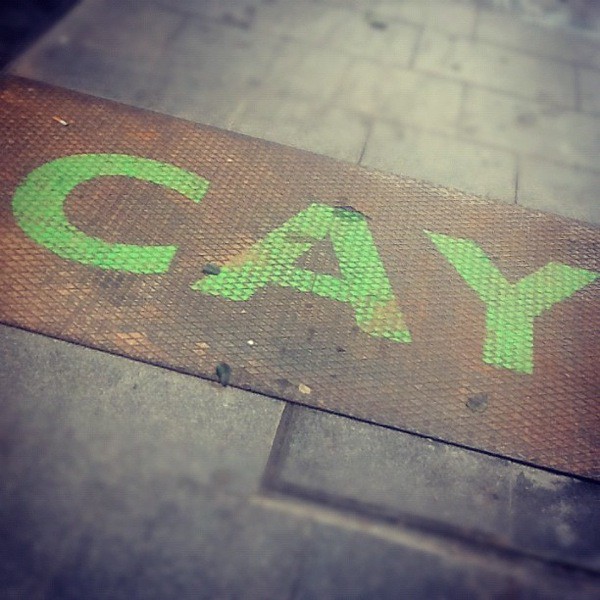A few weeks ago I plugged in an old hard drive and saw some scanned photos from when I used to shoot film. In my memory these pictures were some of the best I had ever taken, and I naturally blamed my tools for the fact that I hadn’t snapped anything better with my various digital cameras in the years since.
But you know what happened? I saw these old pictures and realized that they just weren’t that good. The fact is, I snap better pictures every week using my iPhone. And I think I know why. It’s all Instagram’s fault.
I’m not talking about the filters, although that’s a part of it. Neither am I saying that Instagram automatically makes people better photographers – one glance and the still-not-euthanized Explore section will quickly show that just as full of crap as anything else on the internet. What I’m saying is that shooting your pictures for an audience changes what you do.
The Good Old Days

Vinyl sounded warmer. Books smell romantic. And using film made you concentrate more on each frame. You can hear these arguments all the time. You can also hear the counterpoints: DJs no longer have back trouble from carrying boxes of records; E-books offer a vast and instantly available back catalog; and instant feedback coupled with negligible cost means people improve as photographers way quicker than in the days of film.
All true, and all utterly missing the point.
I’d argue that the reasons I take better pictures these days are twofold. One, I always, always have my iPhone with me and ready to shoot. And the second, perhaps most important, is that I’m shooting for an audience.
The Process
Here’s how I take a picture these days:
- I see something interesting. In other times, even with a digital camera around my neck, I might pass the picture by. After all, who cares that the stickers in the Italian restaurant window actually look pretty funny in juxtaposition? Even a great snap of it will languish on my hard drive, unseen, forever. Now, though, I stop and take the picture. Why? Because I have somebody to show it to. It’s as if I had a friend walking with me, a friend to whom I could point out the funny thing I just saw so we could laugh at it together.
- Take the picture. Again, if I was snapping for myself I’d probably forgive a framing error, or ignore the lack of perfect focus. But I know that this photo will be public, and that 700+ people will be looking at it (750 followers isn’t much, but that’s not the point. 20 would be enough to make me think twice about posting junk), so I take the time to frame and focus. More importantly, I take the time to tell a story with my picture.
The best piece of advice I ever got was to tell a story with my pictures.
This was the best piece of advice I ever got. Tell a story. That’s what keeps people’s eyes on your picture when they’re flicking through a magazine, or walking around a gallery, and it’s even more important when they’re scrolling through a photo stream. And when I’m snapping for an audience [1] I remember this advice a lot more easily than I do when I’m snapping for myself. So I while I’m not going to stick the iPhone on a tripod or anything like that, I will make multiple attempts at the shot until I get it more or less right.
- Edit. I almost never take a picture with the Instagram app itself. You can’t zoom. There’s no HDR, and no matter how quickly you can unlock your iPhone and launch Instagram, the native camera app is one swipe away at all times. Plus, I often process the pictures in other apps first. That app might be something like Snapseed. Or maybe I want to post a non-square picture, so I’ll use SquareReady. Diptic is handy for combining a few frames into one (a rather literal take on “telling a story”), and there are lots more. Also, I’ll often take a picture now and share it later. This sounds like it goes against the immediacy I’m talking about here, but it’s not. It’s just that the situation I’m in might be a little too immediate. Like I’m riding a bike, or walking with friends and unwilling to be the dick who starts playing with his phone.Instagram is actually pretty great for this, as it’ll use the location data of the photo where it was taken, not where you’re posting from now (although beware: if you use the “send to Instagram” feature found in many apps, the location data will be stripped out. You should take the extra step of saving to the camera roll).In the edit comes a refining of whatever idea I had when I took the shot. It’s a lot easier to do this right away, or soon after, while the reason for the picture is still in your head. I might use Instagram’s blur to soften the background if the subject is the point of the picture and I couldn’t remove distractions with clever framing. And I’ll probably at least check to see how the X-Pro II filter looks, even if I edited the picture elsewhere. Whatever: the point is that I’m taking time to make the picture the best it can be, whether by using Instagram’s tools or tools from another app. Or none at all – the “edit” might be nothing more than giving the image a quick check and deciding that it’s already perfect.
- The caption. Maybe you weren’t expecting this one, but a caption (or lack of) adds another dimension. It’s like the title on an artwork in a gallery, and can either explain the picture, turn it into a joke, place it in a series of other work or… Well, or anything. The point is that you can use the caption to change the way the viewer looks at your photo. Here’s an example: I once saw a conceptual piece in the KW in Berlin. It was just a block of gray concrete, so I tutted and moved past it quickly. The Lady, though, actually read the card next to the sculpture. There was an aborted foetus inside the concrete block. Now try telling me that context doesn’t matter.
- Post. This is of course just tapping a button to finish things off, but it also marks the end of your construction of an artwork. This is important:
Like an Exhibition of a Single Work – Every Single Time
No matter how good your photos are – whether from an iPhone or a Lomo or a Leica – they’re not worth much until somebody sees them.
If you keep a stack of cash under your bed until you die, never spending a penny of it, then it was never anything more to you than a pile of paper catching dust, no matter that it was “worth” a million dollars (you’d probably also need quite a tall bed to fit all that cash underneath). And so it is with pictures. You need to share them to give them value.
Instagram is a great way to do this. Sure, Flickr works, as do many other sharing services, but Instagram is so simple in its intent – letting you post and look at pictures – that it’s perfect for your mini one-off exhibitions.

And they are exhibitions. They might be terrible ones, just as there are galleries with bad lighting and which don’t do anything but pin the photos to the walls. But you’re choosing to shoot your lunch, and you’re hashtagging it and showing it to the world, so it is an exhibition.
Every time I take a picture for Instagram I create a work and consider how to present it before putting it on show. I’m not saying that every one of my Instagrams is a work of art – take a look at my photo stream and you’ll see that’s not the case – but I am saying that I put some thought into them. And that I did it because of you, the audience.
And if you think these pictures are bad, you should have seen the ones I used to take.
The Problem of the Non-Connected Camera
What about regular cameras? Do they have any chance? You might have noticed that point and shoots have all-but disappeared, at least as a segment that anyone (including manufacturers) cares about. These days the market is in the high-end, with SLRs getting cheap enough to be a viable next-step from an iPhone, and mirrorless cameras that are frankly amazing little devices. But they all have at least some of the following problems:
- No GPS
- No sharing
- No editing
GPS doesn’t seem so important until you travel. I took only my iPhone to use as a camera on a trip to Paris last year, because I wanted to be able to see the pictures on a map. It’s not really important for the purposes of this article, which is about how sharing photos makes you a better shooter, but its enough to stop me taking a picture. And if I don’t take it, I can’t share it.
You lose momentum in the gap between taking and looking
The other two are the killers. Both can be added: You can use an Eye-Fi card to send pictures to your iPhone. Or process the pictures on your computer and post them later. But will you? More importantly, this gap between taking the pictures (an act which is now reduced to merely gathering images to do something with later) and editing them removes the audience that is looking over your shoulder every time you Instagram something. When I Instagram a picture, the knowledge that I have an audience informs every stage. Taking pictures “for later” removes this immediacy, along with the need to get it right right now.
It’s like shooting film compared to using digital. You lose momentum in the gap between taking and looking.
Attention Spans
The problem with all this is that it encourages single pieces of work. Where do the photo essays fit in? A photographer shooting the Vietnam war would wire photos back to the picture desk whenever he got to a hotel with a bathroom where he could develop the films. This meant that he could be shooting alone for weeks at a time. This also gave him the time to build a set of pictures that could work together. Who has that luxury today?

Maybe there’s a way to take the urgency you feel when Instagramming – including the need to make your work good enough for an audience (however notional) – and apply that to the rest of your photos. Maybe when you take a walk with your shiny new Fujifilm X100s (to use a totally random example), you could do it as if you are about to Instagram every image you take. You won’t be able to edit it, or caption it, or even post it to the internet right away, but you can stop to think if the picture is really worth taking before you press the shutter. You can consider what you want to show in the picture, what story you’re trying to tell. You can decide what is the most important thing in the frame and try to leave everything else out.
Not only will this cut out the amount of cruft that gunks up your memory card, it’ll also make you excited about editing when you get back to your Mac or your iPad. And maybe you’ll end up with a set of pictures that can be shown off together. That’s when you head for Flickr. Or even – if you can stand not seeing your Notification Center light up with stars or likes right after posting – hang your paper prints in a real live gallery.
- This isn’t to say I’m all-out trying to please an audience. That’s the kind of behavior that ends with reality TV and shitty summer blockbusters (you know what else was better in the old days? Summer movies. Back in 1972, Deliverance was a summer blockbuster, not some frikkin’ Transformers sequel). ↩
![How Instagram Made Me a Better Photographer [Opinion] Unknown.jpeg](https://www.cultofmac.com/wp-content/uploads/2013/04/Unknown.jpeg)

